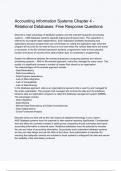Exam (elaborations)
Accounting Information Systems Chapter 4 - Relational Databases_ Free Response Questions (1)
- Institution
- 9.4.1 Transaction Processing Systems
Accounting Information Systems Chapter 4 - Relational Databases_ Free Response Questions (1)
[Show more]



